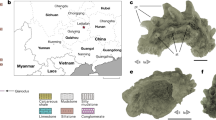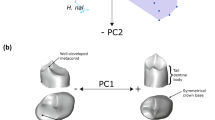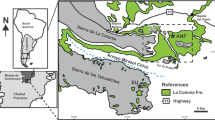Abstract
The first fossil remains of marmosets, an isolated incisor, premolar, and molar, all similar in size toCallithrix species, have been discovered in the middle Miocene La Venta fauna of Colombia. The M1 is referred to a new genus and species,Micodon kiotensis, characterized by a fully developed hypocone and low occlusal relief. The P4 and I1 resemble those ofCallithrix, suggesting a close affinity with callitrichin marmosets. In combining small size with a four-cusped morphology,Micodon demonstrates the shortcomings of typological definitions of platyrrhine families and suggests that small body size may have preceded the tricuspid molar pattern in marmoset evolution. The 14- to 15-Ma date for the La Venta suggests that marmosets are an at least moderately ancient radiation, contrary to estimates based upon the molecular clock.
Similar content being viewed by others
References
Fields, R. W. (1959). Geology of the La Venta badlands, Colombia, South America.Univ. Calif. Publ. Geol. Sci. 32: 405–444.
Ford, S. M. (1980). Callitrichids as phyletic dwarfs, and the place of the Callitrichidae in Platyrrhini.Primates 21: 31–43.
Hayashida, A. (1984). Paleomagnetic study of the Miocene continental deposits in La Venta badlands, Colombia.Kyoto Univ. Overseas Res. Rep. New World Monkeys 4: 77–83.
Hershkovitz, P. (1977).Living New World Monkeys (Platyrrhini) with an Introduction to Primates, Vol. 1, University of Chicago Press, Chicago.
Hirschfeld, S. E., and Marshall, L. G. (1976). Revised faunal list of La Venta fauna (Friasian-Miocene) of Colombia, South America.J. Paleontol. 50: 433–436.
Marshall, L. G., Pascual, R., Curtis, G. H., and Drake, R. E. (1977). South American geochronology: Radiometric time scale for middle to late Tertiary mammal-bearing horizons in Patagonia.Science 195: 1325–1328.
Rosenberger, A. L. (1979a).Phytogeny, Evolution and Classification of New World Monkeys (Platyrrhini, Primates), Ph.D. thesis, City University of New York, New York; University Microfilms, Ann Arbor, Mich.
Rosenberger, A. L. (1979b). Cranial anatomy and implications ofDolichocebus, a late Oligocene ceboid primate.Nature 279: 416–418.
Rosenberger, A. L. (1981). Systematics: The higher taxa. In Coimbra-Filho, A. F., and Mittermier, R. A. (eds.),Ecology and Behavior of Neotropical Primates, Vol. 1, Academia Brasileira de Ciencias, Rio de Janeiro, pp. 9–27.
Rosenberger, A. L. (1983). Aspects of the systematics and evolution of the marmosets. In Thiago de Mello, M. (ed.),A Primatologia No Brasil, UFMG, Belo Horizonte, pp. 159–180.
Rosenberger, A. L. (1985). Fossil new world monkeys dispute the molecular clock.J. Hum. Evol. 13: 737–742.
Rosenberger, A. L., and Coimbra-Filho, A. F. (1984). Morphology, taxonomic status and affinities of the lion tamarins,Leontopithecus (Callitrichinae, Cebidae).Folia primatol. 42: 149–179.
Sarich, V. M., and Cronin, J. E. (1980). South American mammal molecular systematics, evolutionary clocks, and continental drift. In Ciochon, R. L., and Chiarelli, A. B. (eds.),Evolutionary Biology of New World Monkeys and Continental Drift, Plenum Press, New York, pp. 399–421.
Setoguchi, T. (1985).Kondous laventicus, a new ceboid primate from the Miocene of the La Venta, Colombia, South America.Folia primatol. 44: 96–101.
Setoguchi, T., and Rosenberger, A. L. (1986). Some new ceboid monkeys from the Miocene of Colombia.J. Vert. Paleontol. (in press).
Stirton, R. A. (1951). Ceboid monkeys from the Miocene of Colombia.Univ. Calif. Publ. Bull. Dept. Geol. Sci. 28: 315–356.
Szalay, F. S., and Delson, E. (1979).Evolutionary History of Primates, Academic Press, New York.
Author information
Authors and Affiliations
Rights and permissions
About this article
Cite this article
Setoguchi, T., Rosenberger, A.L. Miocene marmosets: First fossil evidence. Int J Primatol 6, 615–625 (1985). https://doi.org/10.1007/BF02692292
Received:
Revised:
Issue Date:
DOI: https://doi.org/10.1007/BF02692292




